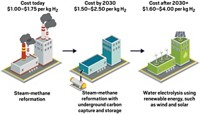Advertisement
Grab your lab coat. Let's get started
Welcome!
Welcome!
Create an account below to get 6 C&EN articles per month, receive newsletters and more - all free.
It seems this is your first time logging in online. Please enter the following information to continue.
As an ACS member you automatically get access to this site. All we need is few more details to create your reading experience.
Not you? Sign in with a different account.
Not you? Sign in with a different account.
ERROR 1
ERROR 1
ERROR 2
ERROR 2
ERROR 2
ERROR 2
ERROR 2
Password and Confirm password must match.
If you have an ACS member number, please enter it here so we can link this account to your membership. (optional)
ERROR 2
ACS values your privacy. By submitting your information, you are gaining access to C&EN and subscribing to our weekly newsletter. We use the information you provide to make your reading experience better, and we will never sell your data to third party members.
Energy
Editorial: What price for clean hydrogen?
by Michael McCoy
July 2, 2023
| A version of this story appeared in
Volume 101, Issue 21
While editing this week’s cover story on the electrolyzers needed for clean hydrogen production, I couldn’t help wondering if producing clean H2 really makes sense on a national scale (page 24). The idea is to run low-carbon electricity through electrolyzers that split water into hydrogen and oxygen. The hydrogen can then be stored and used as a fuel or as a raw material used in place of oil or natural gas.
It’s a nice idea, and one that is already being carried out to a limited degree. But it is a multistep process and not a very efficient one. How many solar panels would be required to generate the electricity needed to make all of that green hydrogen?
I asked the story’s author, C&EN business reporter Craig Bettenhausen, for guidance, and he pointed me to a clean-hydrogen road map just released by the US Department of Energy (DOE). At 99 pages, it’s not for the faint of heart, but it did answer a number of my questions on the potential for and challenges of clean hydrogen.
You might ask: Why harness electric energy to turn water into hydrogen only to burn the hydrogen to produce energy again?
The answer is that while cars and a lot of industrial businesses can run on electricity, other sectors—including airlines, long-haul trucking, and the chemical industry—need a more potent and portable source of energy, be it hydrogen itself or a liquid fuel made from hydrogen and carbon dioxide.
As Bettenhausen’s story notes, the DOE road map sets a goal of producing 50 million metric tons (t) of clean hydrogen per year by 2050. That year is also the target the US—and many other high-income countries—has set to be carbon neutral. Clean hydrogen would be providing 10% of the emissions reductions achieved in the US at that point.
To get there, hydrogen must be abundant and cheap. In 2021, the government set a goal it calls “111”—for reducing the cost of clean hydrogen to $1 per 1 kilogram in 1 decade. It’s a long-shot goal given that, as Bettenhausen reports, electrolytic hydrogen now costs about $5–$7 per kg. The DOE also supports converting natural gas to hydrogen and capturing the resulting CO2, an approach that costs about $2 per kilogram.
Bringing down the price of electrolyzers will be a big part of reaching 111, but even more important will be reducing the price of clean electricity while also massively increasing the supply. In addition to its use in hydrogen production, clean electricity will be needed to decarbonize the existing power grid and to fuel future generations of electric vehicles.
It’s notable that the DOE considers more than just wind- and solar-generated electricity to be clean. Nuclear-generated electricity also falls under its definition, as does electricity generated by coal and natural gas power plants that have been fitted with carbon capture equipment.
However we produce clean electricity, we are going to need a lot of it. The road map doesn’t help here, but extrapolating from a 2020 report by the consulting firm BloombergNEF, I estimate that making 50 million t per year of hydrogen via electrolysis would require roughly 2,300 TW h of electricity. That’s about half as much as the entire country generated in 2021, according to the US Energy Information Administration.
How many solar panels would that require? As the DOE emphasizes, solar energy is not the only kind of low-carbon electricity, but for the sake of argument, let’s say that it is.
A study published last year in the Journal of Photovoltaics says a standard, utility-scale solar plant generates about 450 MW h per acre per year. So, producing 2,300 TW h of electricity would require roughly 5.1 million acres. That’s somewhere between the size of Connecticut and Massachusetts and less than the size of Sweetwater County, Wyoming.
Okay, that’s a lot of solar panels, but it’s not an inconceivable amount. I’ll be curious to see where we stand in 2050.
Views expressed on this page are those of the author and not necessarily those of ACS.




Join the conversation
Contact the reporter
Submit a Letter to the Editor for publication
Engage with us on Twitter